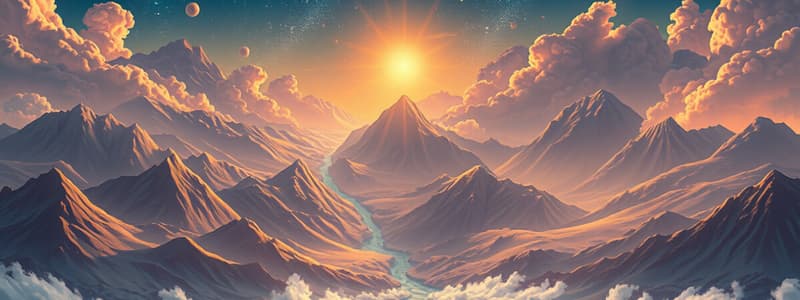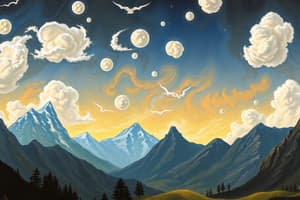Podcast
Questions and Answers
What was the name of the supercontinent that existed before the continents drifted apart?
What was the name of the supercontinent that existed before the continents drifted apart?
- Laurasia
- Pangaea (correct)
- Gondwana
- Panthalassa
Which ocean was formed as a result of North America and South America drifting westward?
Which ocean was formed as a result of North America and South America drifting westward?
- Arctic Ocean
- Pacific Ocean
- Indian Ocean
- Atlantic Ocean (correct)
Who proposed the Continental Drift Theory?
Who proposed the Continental Drift Theory?
- Charles Darwin
- Alfred Wegener (correct)
- Isaac Newton
- James Hutton
What is the name of the sea that was created between Laurasia and Gondwana?
What is the name of the sea that was created between Laurasia and Gondwana?
Which of the following statements is true regarding tectonic plates?
Which of the following statements is true regarding tectonic plates?
How did the Plate Tectonics Theory improve upon the Continental Drift Theory?
How did the Plate Tectonics Theory improve upon the Continental Drift Theory?
Which landmass comprised the present-day North America, Europe, and Asia before breaking away?
Which landmass comprised the present-day North America, Europe, and Asia before breaking away?
What was the role of internal heat in the movement of tectonic plates?
What was the role of internal heat in the movement of tectonic plates?
What is the highest point in the Adirondack Mountain Range?
What is the highest point in the Adirondack Mountain Range?
Which river is considered the longest in North America?
Which river is considered the longest in North America?
Which desert is classified as a cold desert?
Which desert is classified as a cold desert?
What major waterway does the St Lawrence River drain?
What major waterway does the St Lawrence River drain?
Which river is not a major tributary of the Mississippi River?
Which river is not a major tributary of the Mississippi River?
What bodies of water comprise the Great Lakes?
What bodies of water comprise the Great Lakes?
Which of these statements is true about the Cascade Range?
Which of these statements is true about the Cascade Range?
Where does the Colorado River flow through?
Where does the Colorado River flow through?
Which river is a significant river flowing into the Arctic Ocean?
Which river is a significant river flowing into the Arctic Ocean?
Who is historically credited with discovering North America?
Who is historically credited with discovering North America?
What major physical feature is found in the Western Cordilleras?
What major physical feature is found in the Western Cordilleras?
Which river flows through the Great Plains in the United States?
Which river flows through the Great Plains in the United States?
What is the highest peak in the Rocky Mountains?
What is the highest peak in the Rocky Mountains?
Which of these is considered an autonomous territory rather than an independent country?
Which of these is considered an autonomous territory rather than an independent country?
What is the average elevation of the Appalachian Mountains?
What is the average elevation of the Appalachian Mountains?
What earthen feature characterizes the Grand Canyon?
What earthen feature characterizes the Grand Canyon?
Which region is primarily suitable for agricultural production due to fertile plains?
Which region is primarily suitable for agricultural production due to fertile plains?
Which language is NOT widely spoken in North America?
Which language is NOT widely spoken in North America?
What connects North America and South America?
What connects North America and South America?
What type of mountains are the Sierra Madre primarily made up of?
What type of mountains are the Sierra Madre primarily made up of?
What is the largest canyon in the world?
What is the largest canyon in the world?
Which geographical feature is found in the Eastern Plateaus?
Which geographical feature is found in the Eastern Plateaus?
Which country is NOT one of the three large countries in North America?
Which country is NOT one of the three large countries in North America?
Flashcards are hidden until you start studying
Study Notes
Formation of Continents
- Continents were once a single supercontinent named Pangaea, surrounded by the ocean Panthalassa.
- Alfred Wegener proposed the Continental Drift Theory in 1912, explaining the movement of continents.
- Pangaea split into two major blocks: Laurasia (North America, Europe, Asia) and Gondwana (South America, Africa, Australia, Antarctica, India).
- The Tethys Sea formed between Laurasia and Gondwana as they drifted apart.
- About 65 million years ago, North America separated from Laurasia; South America, Africa, India, Madagascar, Australia, and Antarctica separated from Gondwana.
- The Atlantic Ocean formed from the westward drift of North and South America; the Indian Ocean formed from India's northward drift.
- The Plate Tectonics Theory advanced the understanding of continental movement based on shifts in tectonic plates, moving slowly on the Earth's molten mantle.
History of North America
- Christopher Columbus is credited with discovering North America, but Vikings likely arrived first.
- Native American tribes and the Aztec civilization inhabited North America before European colonization.
- The United States, the most populous country in North America, emerged in the late 1700s and is considered a "melting pot" of cultures.
- Paleo-Indians are believed to be among the first inhabitants, migrating from Asia.
Location and Boundaries
- North America is situated in the Northern and Western Hemispheres, bordered by the Pacific, Atlantic, and Arctic Oceans.
- Major features include the Arctic Ocean to the north, the North Atlantic Ocean to the east, and the Caribbean Sea to the southeast.
- It connects to South America via the Isthmus of Panama, where the Panama Canal was constructed.
Countries and Capitals
- Major countries: Canada, USA, Mexico; smaller countries cluster in the central region.
- Greenland is an autonomous territory of Denmark, with Nuuk as its capital.
- English, Spanish, and French are the primary languages due to historical colonization.
Major Physical Features
- Four main physical divisions: Western Cordilleras, Great Plains, Eastern Plateaus, Central Lowlands.
- Western Cordilleras: Features young fold mountains like the Rocky Mountains; important plateaus include the Columbia and Colorado Plateaus; includes the Grand Canyon.
- Great Plains: Vast semi-arid grasslands drained by major rivers.
- Eastern Plateaus: Extend from Hudson Bay to the Gulf of Mexico, include the Appalachian Mountains, Piedmont Plateau, and Atlantic Coastal Plain.
- Central Lowlands: Fertile plains suitable for agriculture and livestock.
Mountain Ranges
- Rocky Mountains: Longest mountain range in North America, with peak Mt. Elbert at 4,399 meters; diverse wildlife.
- Appalachian Mountains: Oldest mountain chain, running from Newfoundland to Alabama; includes popular subranges like the Great Smoky Mountains.
- Sierra Madre: Mountain range along Mexico’s Pacific Coast, characterized by rainforests and volcanoes; highest point is Mount Whitney.
- Adirondack Mountains: Located in New York, highest point is Mount Marcy; features the largest state park in the U.S.
- Brooks Range: Extends 1,100 km across Alaska, with Mount Chamberlin being the highest at 2,749 meters.
- Cascade Range: Known for volcanoes, part of the Pacific Ring of Fire, highest point is Mount Rainier.
Water Bodies
- North America is bordered by the Pacific, Atlantic, and Arctic Oceans and contains significant seas, gulfs, and bays.
- Major Rivers:
- Missouri River: Longest river (3,767 km), flows into the Mississippi.
- Mississippi River: Second longest (3,734 km), forms one of the largest drainage basins in the world.
- Colorado River: Notable for the Grand Canyon and significant dams; vital for water supply.
- St. Lawrence River: Major eastern Canadian waterway draining the Great Lakes.
- Hudson River: Historically significant, flows through New York.
- Mackenzie River: Longest river in Canada, flows into the Arctic Ocean.
Lakes
- Great Lakes: Comprising Lake Superior, Michigan, Huron, Erie, and Ontario; hold 21% of the world's fresh water supply, providing vital transportation routes.
Deserts
- North America features four deserts: Great Basin, Chihuahuan, Sonoran, and Mojave, primarily located in the western region.
- Great Basin Desert: Largest, cold desert mostly in Nevada.
- Chihuahuan Desert: Located along the US-Mexico border.
- Sonoran Desert: Found in California, Arizona, and Mexico, with major rivers flowing through.
- Mojave Desert: Positioned between the Great Basin and Sonoran deserts, spans California, Nevada, and Arizona.
Studying That Suits You
Use AI to generate personalized quizzes and flashcards to suit your learning preferences.




